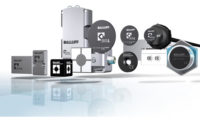Assembly Handbook: Feathering the Nest

Some things just don't get any respect.
In truth, "start with the part," the axiom of automated assembly, could just as easily be "start with the fixture." Parts fixtures, or nests, securely hold parts during automated assembly and transfer operations. Often, the entire product is assembled without ever leaving the fixture. Because the location and orientation of the parts influence every aspect of an automated assembly system, how to fixture the parts is the first item on any machine builder's agenda. For that reason, fixtures are almost always designed and manufactured by the machine builder.
In synchronous systems, the fixtures are mounted directly to the indexing dial or belt. In nonsychronous systems, they are mounted on pallets.
For durability, fixtures are most often made from hardened tool steel, but other options include stainless steel, aluminum, coated aluminum, ceramic, Delrin or nylon. Fixtures can also be made by molding a two-part liquid material, such as polyurethane, around the part. Which material to choose depends on the hardness of the part, the production volume and process variables, such as heat.
Metal fixtures are preferred for metal parts, for high-wear applications and for parts that must be positioned within tight tolerances. Stainless steel is a good choice if the fixtures will be used in a clean room or exposed to corrosive processes.
Plastic fixtures are preferred for delicate plastic parts that could get scratched or marked in metal nests. Metal standoffs are often used in conjunction with plastic fixtures to orient parts with relatively simple shapes. Molded fixtures are used for parts that do not have positive locating features and for parts with complex shapes that cannot easily be machined.
Although fixtures usually outlast the products they're designed to handle, wear can sometimes be an issue, especially if the parts are made of abrasive materials, such as glass. A good machine builder will provide maintenance guidelines and CAD drawings of the fixtures so they can be replaced if necessary.

The cost of fixtures varies widely, depending on the material, the accuracy and flexibility requirements, the complexity of the shape, and the number of fixtures needed. However, fixtures typically cost a few hundred dollars each. Compared with the overall cost of an automated assembly system, the cost of the fixtures is minimal.

A careful analysis of accumulated part tolerances is also critical to fixture performance. The fixture should accommodate the tolerances of the base part, as well as the tolerances of all the parts that will be stacked upon it.
Finding Flexibility
Change orders are a fact of life in manufacturing, but they don't necessarily mark the end of finished fixtures. If the design changes are small, the fixtures can likely be saved and remachined, particularly if they are made of steel. However, if the design changes are radical, the fixtures will have to be scrapped.Flexibility is always an issue in automated assembly. Although machine builders cannot make a fixture that can accommodate, say, a can of shaving cream and a disposable razor, they do have several ways to make fixtures that can handle parts with similar configurations.
One option is to build the fixture with interchangeable subsections. These subsections would consist of all or part of the nest and would be attached to the main fixture with screws or quick-release latches. To speed changeover, the substitute nests are often kept on or near the machine. Similarly, two to four different part profiles can be machined side-by-side into the same fixture. In this case, changeover is accomplished simply by rotating the fixture to the correct profile.
Another option is to machine various features for each part into the same fixture, so that each part has its own locating features but none of the features interferes with the other. In some cases, each part will share some locating features. In other cases, the fixture will have a terraced design, with each part profile slightly smaller and deeper than the other.
Resources
ASSEMBLY would like to thank the following people for their contributions to this article: Richard P. Bodine Jr., chairman of Bodine Assembly and Test Systems (Bridgeport, CT); Jeffrey Frantz, director of applications and acoustic tooling at Branson Ultrasonics Corp. (Danbury, CT); Steve Benedict, sales engineer at ComTal Machine and Engineering Inc. (St. Paul, MN); Bob Klemmer, manager of mechanical engineering at Cox Automation Systems (West Chicago, IL); Jan Aijkens, general manager of Deprag Inc. (Lewisville, TX); De-Wayne Gasman, manager of design and control engineering at Remmele Engineering Inc. (St. Paul, MN); Steve Sarnocinski, regional sales manager at Sonitek Corp. (Milford, CT) and Kyle Kimbro, vice president of Sonobond Ultrasonics (West Chester, PA).Looking for a reprint of this article?
From high-res PDFs to custom plaques, order your copy today!





